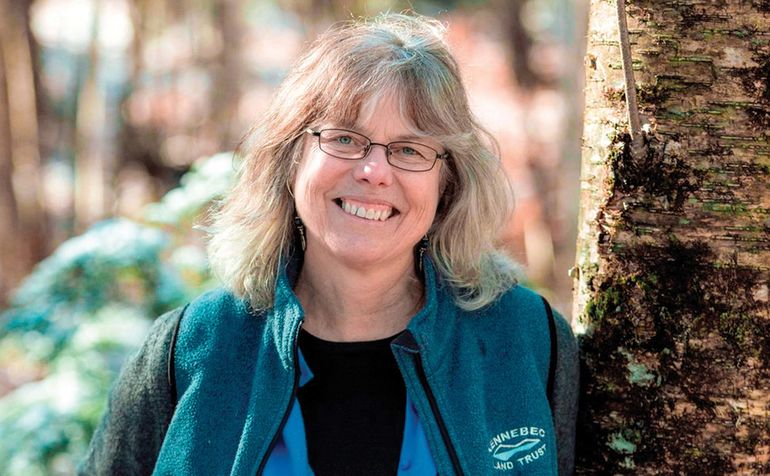Local Wood Works finding innovative ways to expand economic clout of Maine's vast forests
On a recent sunny, cold November morning, about three dozen people gathered in clearing in the woods in New Gloucester.
As they shuffled to keep warm, Steve Chandler, the landowner, spoke for more than an hour about the history of his family's woodlots, how the lots are harvested and today's market for locally produced lumber.
It was the first stop on the third annual Maine Wood + Sustainabilty Tour, one part of Local Wood Works' effort to advance economic development initiatives centered around the region's forests.
Those taking the tour were not only woodlot owners, but architects, engineers and builders, as well as consumers.
Talking about what a well-managed woodlot looks like is the beginning, Theresa Kerchner, executive director of the Kennebec Land Trust, tells the group.
“It's a way to start that conversation with your clients,” she says.
Kennebec Land Trust is one of eight organizations that form Local Wood Works, a collaboration looking to revive old and find new innovative ways to help forests support local economies. “Local” refers to the geographic region that includes New England, New York and the Canadian Maritimes, but much of the focus is on Maine.
In Maine, there are 86,000 owners of woodlots between 10 and 1,000 acres, and they own a collective 5 million acres.
There was a time every community had a sawmill, and local loggers abounded.
“People got their wood from the community,” Kerchner says in an interview a few days after the tour. “Local wood has so much tradition in Maine. It's part of Maine's heritage, people are proud of it.”
Local Wood Works believes people want to come back to it, and that it's doable. “We're lucky to have the resources,” she says. She compares it to the local food movement. “We've done it for lobsters, we've done it for blueberries.”
While heritage and tradition are a large part of the message, “The long-term vision is innovation.”
Long and winding road
This year's tour, held on Nov. 8, embraced both the traditional and the innovative — a snapshot of where the wood comes from and how it can be used.
It began in Steve Chandler's woodlot, one of about 5,000 acres the family owns in New Gloucester, some of which has been logged back to 1782, he told the group.
“It's been a long and winding road to keep this property in the family,” he says. Earlier this year he and the other three owners, his wife, his cousin and his cousin's wife, donated 2,500 acres to the Maine Woodland Owners Land Trust to keep it from being developed.
Chandler tells the group his family doesn't make a profit on its woodlots, which are harvested by one logger, with many of the trees left alone to grow.
“I like 'em big,” Chandler says.
The logger lets him know what the market needs, and cuts accordingly. Most of the hardwood that's harvested is used as firewood and white pine goes out as saw logs.
Chandler says there are a lot of local markets for the wood. “Our logger spends a lot of time on the phone,” he said.
A storyline that works
A few miles away, at Maschino & Sons Lumber in New Gloucester, Wendy Patterson, whose grandfather started the business in 1970, makes it clear a smaller player can thrive in Maine.
“How do you compete in the market?” she's asked.
“We deal with a lot of smaller builders,” she replies — people building houses, or even sheds.
Someone mentions bigger local lumber companies like Hammond Lumber and Hancock Lumber. “They all buy stuff from us,” Patterson says.
She says some of the the woodlot owners who bring their logs in have been doing it since the mill opened.
“[We've] worked with loggers who've been coming in here for years and years,” Patterson says.
“That's a storyline that works for the public,” Kerchner says to the architects and builders in the group. Creating a narrative, she says, helps make the local wood movement more relevant.
Working with a smaller local business also has practical advantages.
Someone mentions markings on lumber that can mar a design.
“If we dress some pine beams for someone,” Patterson says with a laugh, “The last thing I'm going to do is write on them.”
One of the architects asks if Maschino & Sons has a list of what size lumber is available.
“Imagine this,” says Patterson. “Any size you want. Email us and ask. Email is great. We love email.”
Have to have the resource
The tour also visited Hancock Lumber's sawmill in Casco and a woodlot in Yarmouth, where the group saw how wood can be harvested with low-impact equipment.
It ended at Friends School of Portland, on U.S. Route 1 in Cumberland. Wood cleared from the building's four-acre lot was used in its construction.
Kerchner says the effort is wide-ranging — stretching from the woodlot to the sawmill to new uses and innovation, like at the Friends School.
Besides the Kennebec Land Trust, other organizations that make up Local Wood Works are the Coastal Enterprises Inc., Maine Forest Service, Maine Coast Heritage Trust, Grow Smart Maine, the Nature Conservancy and the Northern Forest Center.
“There's a tremendous value in partnering with this variety of organizations,” Kerchner says. The diversity of those groups involved helps maintain the wide-ranging focus.
The effort is funded by the Elmina B. Sewall Foundation, which stresses the link between a healthy environment and healthy communities, Kerchner says.
The effort goes beyond theory and tours — Local Wood Works website includes a Maine Wood Guide, with categories ranging from products, to millwork, to balusters and furniture parts, with lists of local producers.
There's also an interactive map that shows producers across Maine.
“We're trying to organize how people buy wood,” says Lee Burnett, project director for Local Wood Works. “We're trying to make those local mills apparent to people who buy wood and may only know where Home Depot and Lowe's are … We're trying to make it easier.”
Another feature of the website is full-length spec sheets for commercial and residential construction.
Burnett says the group's sessions with builders and architects made it clear it's something they would use.
“It's informational, but it's more than informational,” Burnett says. “It takes an effort, every time someone wants to source locally they have to remember [how to write the specs].”
Keep the forests forests
The big picture is, “How do we make the connection with the professional world, the architects and builders, and also, how do we make the connection with the people in the world?”
Kerchner says local wood is not difficult to use — it's abundant, people are familiar with it. With the decline of the pulp and paper industry, there's a need for the state's forests to continue to be economically viable.
The professional building world in Maine was thinking about the issue before Local Wood Works was formed.
“When we started to meet three years ago, they were already on this track,” she says.
Architects and builders already had clients concerned about things like the carbon benefits and sourcing locally in general.
“They're in their office, and they're thinking about floors, thinking about beams,” she says. “We're trying to put a face on that connection.”
Kerchner says conservation and helping those who want to preserve woodland rather than harvest it is also a major goal.
“We want to keep the forests, forests,” she says. “We want to build an economy based on a sustainable resource, but you can't have the economy if you don't have the resource.”












Comments